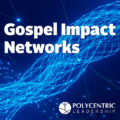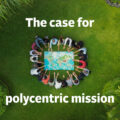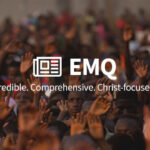Summary: The term polycentric mission has become popular. While the term has a more recent origin, the concept can be traced to the inception of the church. In its earliest days, no one place held authority. The West became a Christian center for a millennia, but now we see a return to polycentric Christianity that goes from everyone to everywhere.
GUEST POST BY ALLEN YEH
The concept of polycentric mission is currently in vogue. But where did it originate? And is it a new concept? Because I wrote the book Polycentric Missiology,[i] many people have asked me whether I coined the term. The truth is more complex and requires a historical overview as well as unpacking a fuller definition.
Christianity Was Polycentric Originally … and Is Again
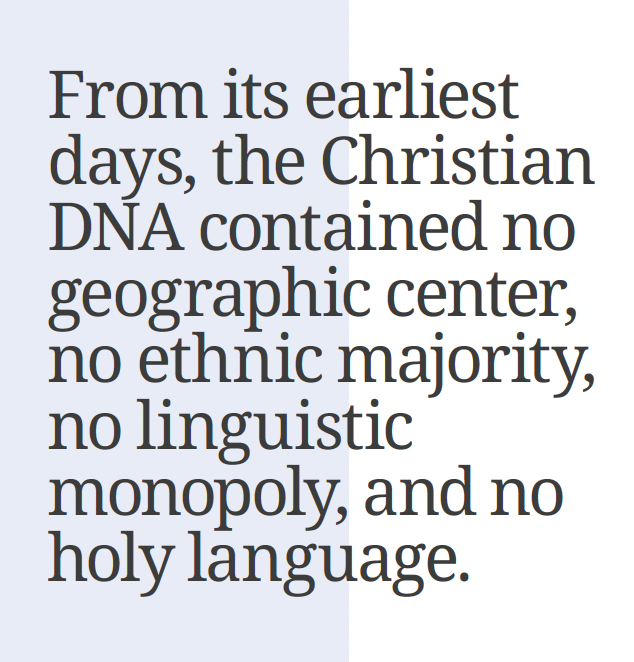 Polycentric simply means many centers, and this aptly describes God’s global mission. Starting with Israel, we can see God’s polycentric plan taking shape. The promised land was missionally located at the crossroads of three continents – Asia, Africa, and Europe. After the birth of the church recorded in the book of Acts, Christianity spread tri-directionally from there to Asia Minor (aka Turkey), Ethiopia in Africa, Greece in Europe, and even as far as India.[ii]
Polycentric simply means many centers, and this aptly describes God’s global mission. Starting with Israel, we can see God’s polycentric plan taking shape. The promised land was missionally located at the crossroads of three continents – Asia, Africa, and Europe. After the birth of the church recorded in the book of Acts, Christianity spread tri-directionally from there to Asia Minor (aka Turkey), Ethiopia in Africa, Greece in Europe, and even as far as India.[ii]
<p”>The early church continued this tri-continental idea with the original five Patriarchates (the seats of the five bishops). Those were in Rome (Europe), Constantinople (Eurasia), Antioch (Asia), Jerusalem (Asia), and Alexandria (Africa).
Many global faiths claim one geographic center. Muslims claim Mecca. For Judaism, it’s Jerusalem. In Hinduism, Varanasi is the center. Mormons see Salt Lake City as their center. And while Rome may be a center for Catholics, global Christianity has no center. From its earliest days, the Christian DNA contained no geographic center, no ethnic majority, no linguistic monopoly, and no holy language.
Twentieth century Catholic historian Hilaire Belloc famously said, in reference to Christianity, “Europe is the faith and the faith is Europe.” But his assessment was incomplete. For about a millennium (approximately AD 800–1800), the West became the bastion of Christianity.[iii] This happened when Islam’s growth pushed Christianity from its birthplace in the Middle East to the west toward Europe.
This reached its peak during what Yale church historian Kenneth Scott Lotourette called the “Great Century of Missions.”[iv] William Carey, known as the father of modern missions, wrote his great work An Enquiry in 1792. It inspired missionaries to launch the nineteenth century as the greatest spread of Christianity up to that point in history, seeing Christianity reach every corner of the globe.
Many regard the twentieth century as a reversal of fortunes for Christianity, as secularism, modernism, and the ideas of the “Masters of Suspicion” (Nietzsche, Marx, and Freud) held sway. But as Gordon-Conwell Seminary President Scott Sunquist points out in his book, The Unexpected Christian Century, it was only in the West that Christianity declined that century.[v] In the Majority World (Africa, Asia, and Latin America), the Christian faith went from being received from nineteenth century Western missionaries to being indigenous to those lands.
As new centers developed, Christianity returned to first century polycentrism. This was, therefore, a reformation not a revolution as Christianity originated in non-Western lands. It is the Romans 9–11 idea: Jews were the original branches, Gentiles are simply the ingrafted olive shoots, and if all Jews eventually converted to Christianity, it would be more of a converted back rather than a converted to. Similarly, Majority World peoples were the original Christians, and Westerners were the ingrafted ones. So in many ways Christian faith has returned to its birthplace.
The nineteenth century was the great century of the Majority World receiving missions, but the twentieth century was the great century of the Majority World making Christianity their own again. Now, the twenty-first century is the great century of the Majority World sending missions. With these realities in mind, I subtitled my book, Polycentric Missiology, with “from everyone to everywhere.” The implications of missions no longer being “from the West to the rest” are staggering.
Implications of Polycentric Christianity
Sub-Saharan Africa is arguably a new center of Christianity sitting in contrast to a highly secularized Europe. As a result, we are seeing phenomena such as the largest church in London being Nigerian (Kingsway International). “Reverse mission” with Christians from the Majority World taking the gospel to places where it once flourished has become common.
Majority World church leaders now outnumber Western church leaders, and they set ecclesial agendas for formerly Western denominations such as the Anglican Church or the United Methodist Church. Because the Majority World tends to be more morally conservative, the ecclesial agendas are often countercultural (as opposed to Western Christianity which often follows the latest cultural trends).
While Western Christians tend to be more Christocentric, Majority World Christians are more likely to be Pentecostal. This shift from the Second to the Third Person of the Trinity does not need to provoke anxiety as Jesus explained that a shift to the Holy Spirit does not decenter Jesus but glorifies the Son (John 16:7–15).
Missions is now done out of poverty and powerlessness rather than out of riches and strength. This decouples missions from colonialism and better reflects the realities of the early church. Because many Majority World missionaries do not have the financial resources of the West, they may not necessarily fly to the other side of the world for missionary service, but sometimes are more active within their own country or region in breaking dividing walls. So while crossing international borders is less common, focus remains on crossing cultural and ethnic boundaries.
The Majority World does not think in as binary terms as the West (e.g., complementarianism vs. egalitarianism, Calvinism vs. Arminianism, paedobaptism vs. credobaptism, premillennialism vs. amillennialism, etc.), so more women are highlighted as leaders. They accept anyone who is willing and empowered. With the percentage of Christian women worldwide outnumbering men, this creates a wealth of human resources in the Majority World, even if they lack material or financial wealth.
However, this surplus in numbers is not yet matched with opportunities to grow in depth (training, education, resources, discipleship, rather than evangelism). The Majority World does not have adequate seminary education, leading many to go to the West for education. But this is unsustainable. It’s expensive and relationally costly as they often have to leave their families and ministries behind for years on end. Western seminaries also often do not have a curriculum that is applicable to Majority World home contexts.

Origins of Polycentric Mission Terminology
Who coined the term polycentric mission? Multiple people developed this concept simultaneously. To give a parallel example, where did modern Pentecostalism come from? Many will point to the Azusa Street Revival starting in 1906 in Los Angeles with African American preacher William Seymour.
However, Walter Hollenweger, a Swiss theologian and the first Secretary for Evangelism in the Division of World Mission and Evangelism of the World Council of Churches, came up with his (coincidentally named) polycentric theory in his book Pentecostalism: Origins and Developments Worldwide (Hendrickson, 1997).
In it, he says that the Holy Spirit was moving in multiple places around the world simultaneously seemingly with no obvious connections to each other. Multiple Pentecosts sprung up in Wales (1903–04), India (1904–05), Chile (1906–07), Korea (1907), in addition to the famous one at Azusa Street, all around the same time.
Similarly, the phenomenon of polycentric mission appeared in multiple places. Who influenced whom is difficult to presume or track, although it is equally likely that the Holy Spirit inspired all of us in the same time period.
One of the first mentions of this appears in 2013. The theme of the Sixth International Munich-Freising Conference held in July that year was “Polycentric Structures in the History of World Christianity.” This developed out of what has come to be known as the “Munich School of World Christianity” which aims to rewrite Christian history as not just one of Western dominance. The conference proceedings were collected into a published book a year later.[vi]
In October 2016, my book, Polycentric Missiology, came out. At the same time, the World Evangelical Alliance-Mission Commission (WEA-MC), met in Panama[vii] with the Global Consultation theme “Mission in Many Voices: Polycentric and Polyphonic Mission.”[viii] This was not coordinated or planned.
Inspired by my book, Joseph Handley (President of the mission organization A3[ix]), wrote his PhD dissertation on “Polycentric Mission Leadership,” and defended it successfully on February 11, 2020. His dissertation has since been published as a book – Polycentric Mission Leadership: Toward a New Theoretical Model for Global Leadership.[x]
On September 8, 2020, the Oxford Centre for Mission Studies (OCMS) held their annual Montagu Barker lectureship. The theme was “Polycentric Theology, Mission, and Mission Leadership.” The four speakers invited included myself, Joe Handley, Mary Lederleitner, and Kirk Franklin. All of these lecture papers have been published as articles in a recent journal issue of Transformation.[xi] My focus in particular was on new theologies that naturally emerge from polycentric Christianity, and my paper was entitled “Majority World Theologies.”[xii]
In April 2021, Goethe University Frankfurt started a series of Zoom lectures on “Polycentricity and Plurality of Premodern Christianities.” Since then, they’ve done a Zoom lecture once a week showcasing paper presenters from all over the world. In fact, because the COVID-19 pandemic accelerated the acceptance of Zoom conferences, a more global and polycentricgroup participated particularly from places with fewer financial resources.
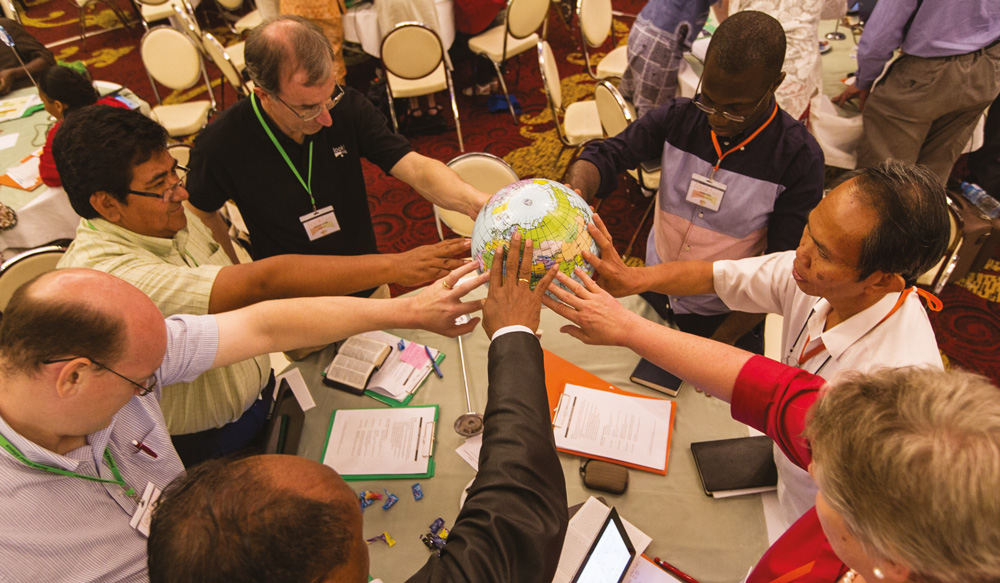
On June 9, 2023, Australian missiologist Graham Joseph Hill began a series of blog posts about polycentric mission. In his first post in the series, he wrote about the five integrated approaches to transforming World Christianity and Mission, Theology, and Ministry. He dubbed them the P.I.P.P.I. (Polycentric, Integral, Pentecostal, Polyvocal, and Intercultural).[xiii] Together he calls the church’s future a “holisticostal” approach.
New Zealand Māori Jay Matenga, the now head of the WEA-MC, and I connected at the next WEA-MC Global Consultation in Chiang Mai (Thailand) in January 2023. He and his team chose the theme of the gathering which was “Our Missions Future: Local Impact, Ripples, and Waves.”[xiv] Out of it will come the volume “Polyfaceted Mission.”
All of these ideas seem to be converging in the fourth Lausanne Congress (L4) which will take place on September 22–28, 2024, in Seoul, South Korea. L4 is employing a polycentric process of listening and learning in determining what the Holy Spirit is saying to the global church. The key questions asked in this multi-year discernment process are:
- What are the most significant remaining gaps or remaining opportunities toward fulfillment of the Great Commission?
- What promising breakthroughs or innovations do you see that can accelerate the fulfillment of the GC?
- In what areas is greater collaboration most critical in order to see the fulfillment of the GC?
- Where is further research needed?
- To whom else should we be listening as part of this process?
Their polycentric process leads to the Lausanne agenda. The polycentric agenda leads to the Lausanne events. And their polycentric events lead to their Lausanne actions. The Seoul 2024 theme is “Let the Church Declare and Display Christ Together.” This seems to center on unity and proclamation. But the togetherness aspect implies polycentricity – that every voice is important and needs to be heard and expressed.

What all of this makes clear is that no one person or continent can claim to own the term polycentric mission. It is a shared reality, that is well-attested globally, and is not just the invention of one person or group. This gives good credence to the importance of the phrase.
What’s Next?
Nigerian author Chinua Achebe famously quoted an African proverb which states, “Until the lion has its own historians, tales of the hunt will always glorify the hunter.”[xv] Today, we’re beginning to hear from the lion. New voices, previously silenced by lack of access or resources or not being afforded a seat at the table, are participating in leading and shaping global Christianity. This includes not only underrepresented ethnicities and nationalities, but also women who constitute the majority of the global church.[xvi]
Polycentric missions is taking many forms and doesn’t look the same in every context. When I was at the WEA-MC Global Consultation in Chiang Mai in January 2023, one gentleman confronted me about this. He asked, “If you are saying that mission should be from everyone to everywhere, does this mean that a Christian from Afghanistan should go overseas to, say, Europe to preach the gospel?”
He was very clear that he did not think that was a good idea. Mainly, he thought “brain drain” (or perhaps more accurately, a “soul drain”) would be a disservice to Afghanistan which already has so few Christians. He explained that Christians in a country with very few Christians should stay where they are. Their country needs zealous believers. Resources to go elsewhere may be out of reach. And training for effective cross-cultural ministry may be hard to access.
These obstacles are real and need to be taken seriously. However, the global body of believers needs opportunities to interact with Afghan believers. Without engagement with believers from countries in which Christianity is a very tiny minority and/or persecuted, the global church becomes impoverished. It loses the opportunity to learn and grow from believers well acquainted with suffering.
Another example we can look to is from Albania – the only Muslim-majority country in Europe. From Albania came none other than Mother Teresa. She left her country to go to India and become one of the most famous missionaries in the world. That kind of impact can multiply. Mother Teresa’s ministries have gone global via her organization Missionaries of Charity. It is never about one person, but how God can multiply one person’s influence.
Jesus’s impact was mainly locally to Jews (“Jerusalem”), but he called his disciples to go to their multiethnic neighbors (“Judea and Samaria”). Then Paul and his compatriots went overseas (“the ends of the earth”). In the same way, anyone anywhere can inspire a movement which goes everywhere, no matter where they are, as long as they have a microphone (whether that be a church, an organization, a platform, or a publisher).
It might be that someone like missiologist Lamin Sanneh can leave his home country of The Gambia, take a faculty post at Yale University, get published by Orbis,[xvii] and influence the Christian missions world more broadly this way. Certainly, West Africa could have used him locally, but only in the Lord’s sovereignty can the bigger picture be seen of larger impacts through the world and through history.
Timothy Tennent observed that Christianity is the only religion in the world in which the Scriptures are not written in the language of its founder.[xviii] Jesus spoke Aramaic, and the New Testament was written in Koine Greek, the commercial language of the Eastern Mediterranean in his time. The notion of the translatability of Christianity – even from its start – shows the polycentricity of the faith.
Are the holy Scriptures meant to be in Hebrew or a pagan language? Both. Is God located in heaven or on earth? Both (via the incarnation, which itself was a translation from deity to human). Are God’s people on pilgrimage via the Exodus, or arrived at the promised land/heaven? Both. To live is Christ, and to die is gain. As polycentric mission becomes more and more a reality, we will see amazing fruits being born. It is an exciting time in Christian history to be alive.
Allen Yeh
_________________________
About Dr. Allen Yeh
 Allen Yeh (allen.yeh@biola.edu) is a professor of intercultural studies and missiology at Biola University. He earned his BA from Yale, MDiv from Gordon-Conwell, MTh from Edinburgh, and DPhil from Oxford. He is the author of Polycentric Missiology: 21st Century Mission from Everyone to Everywhere, and co-editor (with Tite Tienou, former Dean of Trinity Evangelical Divinity School) of Majority World Theologies: Theologizing from Africa, Asia, Latin America, and the Ends of the Earth.
Allen Yeh (allen.yeh@biola.edu) is a professor of intercultural studies and missiology at Biola University. He earned his BA from Yale, MDiv from Gordon-Conwell, MTh from Edinburgh, and DPhil from Oxford. He is the author of Polycentric Missiology: 21st Century Mission from Everyone to Everywhere, and co-editor (with Tite Tienou, former Dean of Trinity Evangelical Divinity School) of Majority World Theologies: Theologizing from Africa, Asia, Latin America, and the Ends of the Earth.
This article was reposted with permission from EMQ and was originally published here:
EMQ » January–April 2024 » Volume 60 Issue 1
https://missionexus.org/what-is-polycentric-mission/
Copyright © 2024 by Missio Nexus. All rights reserved. Not to be reproduced or copied in any form without written permission from Missio Nexus. Email: EMQ@MissioNexus.org.
End Notes
[i] Allen Yeh, Polycentric Missiology: 21st Century Mission from Everyone to Everywhere (Downers Grove: IVP Academic, 2016). My book was voted one of the top ten missions books of 2016 by the International Bulletin of Mission Research.
[ii] Indians call their earliest church tradition “Mar Thoma” which is Aramaic for “St. Thomas” who purportedly was the one who first brought the gospel there. Imagine the surprise of the Portuguese Jesuits who landed there in the sixteenth century and realized that Indians had had the gospel longer than them!
[iii] This, of course, implies that Christianity was alive and well outside of Europe for the first eight centuries of its existence. See Philip Jenkins, The Lost History of Christianity: The Thousand-Year Golden Age of the Church in the Middle East, Africa, and Asia – and How It Died (San Francisco: HarperOne, 2009).
[iv] Kenneth Scott Latourette, A History of the Expansion of Christianity, 8 vols. (New York: Harper, 1937–1945).
[v] Scott W. Sunquist, The Unexpected Christian Century: The Reversal and Transformation of Global Christianity, 1900–2000 (Baker Academic, 2015).
[vi] Klaus Koschorke and Adrian Hermann, eds., PolycentricStructures in the History of World Christianity (Wiesbaden: Harrassowitz Verlag, 2014).
[vii] There is an interesting history behind this. The landmark Edinburgh 1910 World Missionary Conference, the “birthplace of the modern ecumenical movement” from whence was birthed the twin movements of the World Council of Churches and the Lausanne Movement, infamously left out Latin America from its proceedings. The Latin Americans, miffed, created their own Panama 1916 conference in response to their omission. The WEA MC’s Panama 2016 conference was a centenary celebration of the Panama 1916 conference.
[viii] MC Global Consultation, “The Panama Statement,” October 8, 2016, https://weamc.global/the-panama-statement/.
[ix] A3 was formerly known as Asian Access, and before that LIFE Ministries. Handley was the successor to Doug Birdsall as President of Asian Access when Birdsall transitioned to being Chairman of the Lausanne Movement.
[x] Joseph W. Handley, Jr., Polycentric Mission Leadership: Toward a New Theoretical Model for Global Leadership (Oxford: Regnum, 2022).
[xi] Marina Behera, ed., Transformation: An International Journal of Holistic Mission Studies 38, no. 3 (July 2021), https://journals.sagepub.com/home/trn.
[xii] Allen Yeh, “Majority World Theologies,” Transformation: An International Journal of Holistic Mission Studies 38, no. 3 (June 2021), https://doi.org/10.1177/02653788211027344.
[xiii] Graham Joseph Hill, “Polycentric Mission and Ministry – ‘From Everyone to Everywhere,’” June 9, 2023, https://grahamjosephhill.com/polycentric-mission/.
[xiv] World Evangelical Alliance, Mission Commission, Global Consultation 2023, “Our Missions Future: local impact, ripples, and waves,” Chiang Mai, Thailand, January 30–February 3, 2023, https://weamc.global/gc23/.
[xv] Jerome Brooks, “Chinua Achebe, The Art of Fiction No. 139,” The Paris Review, no. 133 (Winter 1994).
[xvi] Gina A. Zurlo, Women in World Christianity: Building and Sustaining a Global Movement (Hoboken: Wiley-Blackwell, 2023).
[xvii] Lamin Sanneh, Translating the Message: The Missionary Impact on Culture (Maryknoll: Orbis, 1989).
[xviii] Timothy Tennent, “The Translatability of the Christian Gospel,” blog post, September 16, 2009, https://timothytennent.com/the-translatability-of-the-christian-gospel/.





